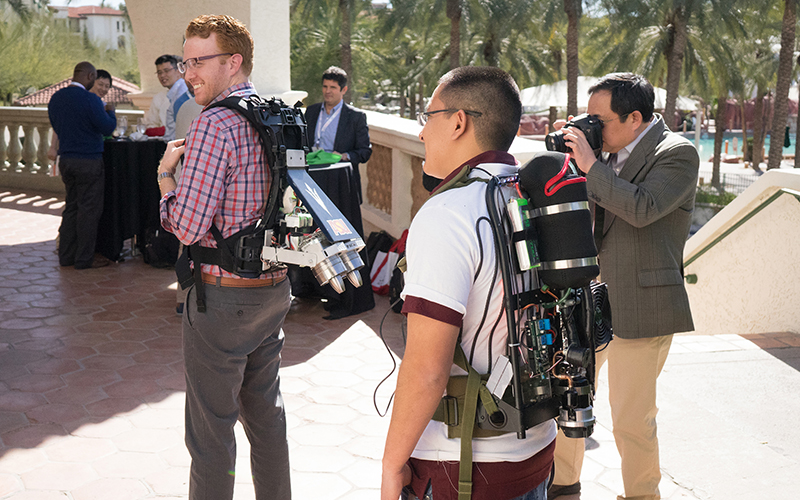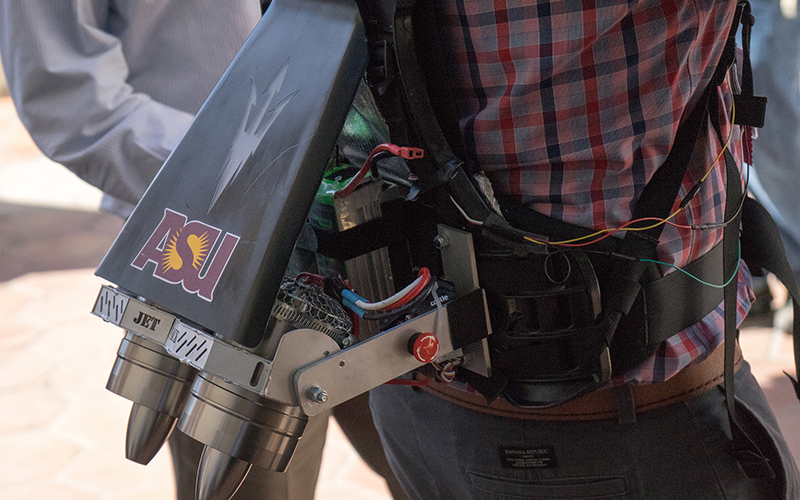
Robert Gregg, left, a professor at the University of Texas at Dallas, tries a jetpack, assisted by demonstrator Eduardo Fernandez, who is wearing a personal cooling device, at the Wearable Robotics Association’s WearRAcon16 in Phoenix on Feb. 10.
(Photo by Travis Arbon/Cronkite News)

The jet pack applies more than 30 pounds of thrust in a downward direction with the goal of enabling the average runner to complete a four-minute mile. Robert Gregg, a professor at the University of Texas at Dallas, wears the jet pack at the Wearable Robotics Association’s WearRAcon16 in Phoenix on Feb. 10. (Photo by Travis Arbon/Cronkite News)
Wearable and implanted devices are the next frontier of military technology and medicine. That was the message at the Wearable Robotics Association’s WearRAcon 16 conference, which opened on Wednesday.
Those machines could be anything from a personal cooling system to an exo-skeleton suit, replacement limbs or even a jet pack. Speakers at the conference said those advances are just a few years away from reality.
The conference, which gathered a group of robotics industry professionals, scientists and academics, runs through Friday at the Arizona Grand Resort & Spa in Phoenix. About 160 attendees listened to experts, explored exhibits and discussed the issues swirling around the emerging field. This was inaugural conference for the Wearable Robotics Association, a Scottsdale-based organization of robotics entrepreneurs and scholars.
The other day @cronkitenews had a reporter in a boat. @ziyi_zeng‘s about to top that with this jet pack. #robotics pic.twitter.com/zorNFiWHUR
— Travis Arbon (@TravisArbon) February 10, 2016
Geoffrey Ling, former director of the U.S. military’s Defense Advanced Research Projects Agency’s Biological Technologies Office, said technology and medical research have advanced enough to begin considering wearable robotics.
“I believe that we are on a threshold of man’s next transformation,” Ling said. “And that is where man and machine become symbiotic.”
Much of that technology is still in the testing phase, but enough is available to provide a glimpse of the future.
Eduardo Fernandez, a graduate student at Arizona State University, is part of a team developing personal machines for military use.
Those projects include a system for reducing the sway of military backpacks and shirts that keep soldiers cool on hot days. But perhaps the one that garnered the most interest from attendees was a jetpack designed to allow anyone to run a four-minute mile.
Fernandez said they haven’t perfected the system, but the current version does improve running times, although not to the extent of enabling the average person to run a four-minute mile.
“On runners that are already pretty close to (running a four-minute-mile), it has,” Fernandez said. “But on average runners, we haven’t seen that much of an increase.”
The concept of wearable systems goes beyond increasing strength or stamina. Some researchers are developing technology to combat diseases or find a workaround for spinal injuries.
David Armstrong, a professor of surgery at the University of Arizona College of Medicine, said wearable robotics could help address foot decay among diabetes patients.
“We don’t think of a hearing aid, we don’t think of bifocals, as some sort of cybernetic device, but in fact they are – they augment what we do,” Armstrong said. “In the future, this is not going to be so exotic and crazy. This is just going to be another part of our life.”
As with any new technology, especially one so heavily tied to the human body, ethical dilemmas are bound to arise. For example, governments or companies could track technology, such as implanted chips, bringing the issue of privacy to the forefront.
“We have to balance the creepy factor … with the great innovations that are happening,” Armstrong said.
Ling said the best way to address potential ethical issues is to be aware of them while maintaining a commitment to advancing the technology.
“We cannot stop what we’re doing because that would be foolish,” Ling said. “We’re going to learn as we move forward, but we have to do it in a way that allows us to ask these very difficult ethical questions and socially relevant questions so that we can be forewarned.”